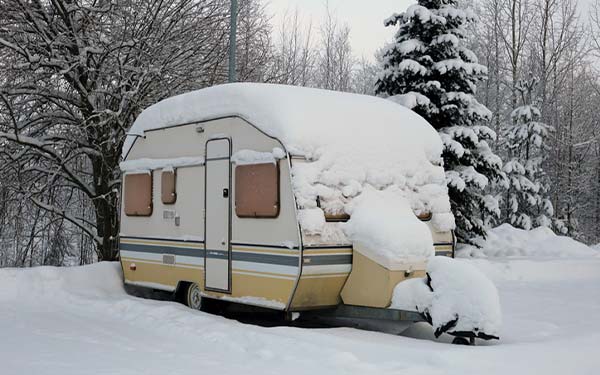Unless you’re a snowbird or active winter RVer, the winter season is when most RVs are put in storage for the off-season. While this may signal the end of a year full of adventure, it’s also a time to prepare and inspect your rig for the next season. And when it comes to winter RV storage, you shouldn’t take any shortcuts. Failing to follow a few key precautions could result in costly repairs down the line.
If you’re looking for tips on how to store your RV during the off-season, this blog will cover the basics you don’t want to forget.
RV Winter Storage Tips for the Off-Season
1. Give Your RV a Thorough Cleaning

Alright, let’s be honest here. After an entire season of RVing, it’s likely your rig is either dirty or really dirty. So before following any winter RV storage advice, it’s best to clean your RV from top to bottom. This means grabbing a ladder, a power hose, and some basic cleaning products to make your RV sparkle. Check out this RV cleaning supplies write-up for our recommendations on the best tools to use for the job.
When preparing for RV winter storage, be sure also to clean out your RV’s interior. You don’t want to return to your RV come springtime and find a forest growing from any leftover veggies in the fridge. Go through and empty every cabinet and storage space inside your RV to avoid any messes.
Pro tip: unplug and defrost your RV fridge and freezer, clean the insides well, then prop open the doors over winter to prevent mold and mildew.
2. Keep Critters Out
When your RV is in winter storage, it becomes a sought-after target for critters looking for a place to hide. Although they may not seem like much of a threat, little critters can cause immense damage inside your RV. Small animals, such as mice, can chew through your furniture, damage electrical wiring, and leave behind unpleasant surprises for you to find.
To keep animals out, give your RV a full inspection, looking for any cracks or openings that wildlife can use to enter your RV. If any gaps are found, seal them properly using caulking or another durable material. To secure any vents, we recommend purchasing RV vent covers for added protection.
3. Draining RV Water

Depending on where you live, you may need to take additional measures to complete your RV winter storage checklist. For example, suppose you live in an area that regularly experiences temperatures below 32 degrees Fahrenheit. In that case, you’ll need to remove any water that could freeze and burst your RV’s pipes.
Begin by draining all the liquids inside your RV’s various tanks, such as the water heater, freshwater, greywater, and blackwater tanks. Every RV is equipped with different hardware, so be sure to look up draining instructions for your specific model. Once emptied, flush and clean your grey and black water tanks to prevent mold or bacteria growth.
Once your tanks are flushed and clean, shift your attention to your RV appliances, such as your sink, toilet, and shower. To get rid of excess water, open all faucets and flush your toilet until they run dry.
Head over to our blog on “How to Winterize Your RV” for more detailed information on winterizing an RV.
4. Purchase an RV Winter Cover
If your winter RV storage plans are to keep your rig outdoors, you’ll need to purchase an RV cover. The cover will help keep your RV’s paint job looking fresh and protect your rig from harsh UV rays, animal droppings, falling tree sap, and much more.
When shopping for an RV cover, search for one that is made of breathable material with a snug fit. This will help keep uninvited guests out while allowing excess moisture to escape.
5. Don’t Forget About Your Tires

Your RV tires face a lot throughout the year, so it’s important not to forget about them when preparing for winter storage. While your tires can hold the immense weight of your rig on the road, keeping them stationary for an extended period could lead to issues such as flat spots.
We recommend parking your RV on a leveled surface to keep your tires strong. Next, use RV blocks or leveling jacks to keep some pressure off your RV tires during the off-season.
6. Fill Your Gas Tank
If you own a motorized RV, don’t forget to fill your gas tank before putting your RV in storage. While this may sound silly since your RV won’t be in use, doing so will keep your fuel tank in good condition. If your tank is empty, the air inside may contain moisture that will then condense, which can lead to costly problems.
After you fill your tank, add a fuel stabilizer. The stabilizer will keep the fuel from breaking down during storage. Once added, run your RV for a few minutes to ensure the stabilizer is carried throughout the engine.
RV Winter Storage and Insurance
As you already know, RV insurance protects your rig while you’re off adventuring. But did you know that it may be possible to save on RV insurance during the off-season? Depending on your insurer, you may be able to adjust your policy to meet your storage-only needs. If you’d like to learn more about your RV insurance options, call our RV insurance specialists today at (866) 501-7335.
The information in this article is obtained from various sources and is offered for educational purposes. Furthermore, it should not replace manuals or instructions provided by the manufacturer or the advice of a qualified professional. No warranty or appropriateness for a specific purpose is expressed or implied.
